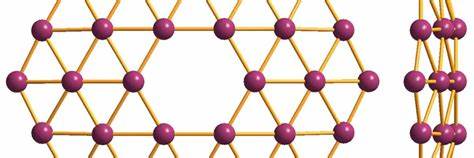Graphene has long been known for its impressive properties. It’s made up of a single layer of carbon atoms in a hexagonal shape. This unique structure gives it exceptional strength while keeping it extremely lightweight, making graphene a popular choice for various uses. But scientists now think they might have found something even better: borophene. This new super material is thinner, lighter, and stronger than graphene. Plus, it has higher conductivity, making it suitable for an even wider range of applications.
Research at Penn State University in Pennsylvania has taken borophene’s potential to a new level. Scientists introduced chirality to borophene, a feature that breaks its mirror symmetry. This innovation, reported in an ACS Nano study, opens up exciting possibilities for using borophene in medical technology. The study indicates that borophene, with its unique qualities, could eventually replace graphene as the top material choice in various fields, especially in medical applications.

Borophene’s Medical Breakthroughs Through Chirality
The Penn State study highlights the innovative ways in which chirality can enhance borophene’s functionality. Chirality allows atoms in borophene to rearrange into various configurations, creating different structures much like the concept of left and right hands. This flexibility has significant implications for medical technology, where the ability to create varying structures from the same base material is extremely valuable. The research team, led by Dipanjan Pan, a professor of Nanomedicine and Materials Science at Penn State, used a technique called solution-state synthesis to achieve these new borophene structures. They combined powdered borophene with other components, then applied pressure and heat to generate high-energy sound waves, which helped manipulate the material’s arrangement. This innovative process allows borophene to assume multiple shapes, adding to its versatility for different applications.
The resulting super material has the potential to revolutionize medical technology, enabling the development of advanced devices that can track cell interactions with greater efficiency and safety. According to Pan, borophene’s unique structure could also pave the way for implantable sensors, drug delivery systems, and imaging applications. The study’s findings indicate that the different polymorphic structures of borophene interact with cells in unique ways, opening doors for more targeted medical interventions.
With its magnetic and electronic properties, this super material could play a crucial role in healthcare, sustainable energy, and other fields. This initial study is just the beginning, and Pan’s team has several projects underway to further explore borophene’s potential. As the research progresses, borophene could emerge as the next “super material,” potentially having a broader impact than graphene, leading the way in medical innovation and other high-tech applications.
For further Information: https://constrofacilitator.com/
Read our previous articles:
First 5G-enabled Surgery performed by Doctor (scitechupdate.com)
Hitchhiking Aliens: New Research into Panspermia (scitechupdate.com)
What Is Inside the Moon? (scitechupdate.com)
Two new COVID variants, called ‘FLiRT’ in the United States (scitechupdate.com)
Sex and Gender Studies: Unlocking Equality and Social Justice (scitechupdate.com)
https://scitechupdate.com/index.php/israel-advances-cancer-treatment-with-genomic-profiling/https://scitechupdate.com/index.php/stomach-cancer-causes-signs-and-treatment/

